#typographic murals
Photo
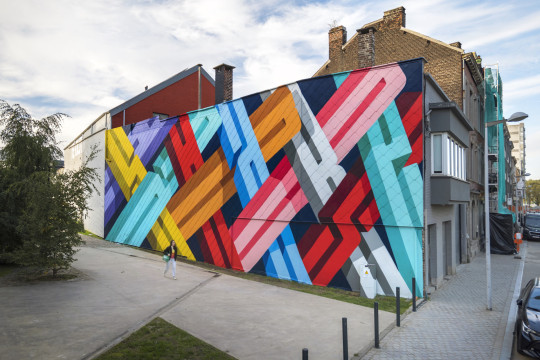
“Shake Hands” in Leige, Belgium.
Vibrant Letters Drift and Twist in Bold Typographic Murals by Pref
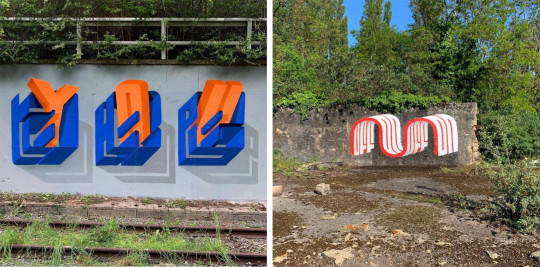
Left: “You are the one.” Right: “Off and on”

“Put you in a box” in Liège, Belgium

“Nuture, Nature” in Sand City, California
#pref#artist#art#street artist#street art#mural#letters#typographic murals#leige#belgium#sand city#california
1 note
·
View note
Text
Forward, but Never Forget/XOXO - Ch: 23 - Sumpside Waltz (Part II)

The streets widen. Vi's steps slow. Ahead, a wall is bathed in a halo of lustrous lantern-orange light. A knot of Fissurefolk are gathered under its glow. Some smoke cigarettes and whisper somberly among themselves. Others kneel, their features cast in shadow. Their lips stir; their heads are bowed.
Vi realizes they are praying. To what, she can't tell. But whatever they believe in, it's not a goddess flung from the sky.
Their faith is rooted in flesh.
Her sister's flesh.
Vi stops short. Her eyes take in the mural. It covers the wall in its entirety. Gang insignias splash the charred base. Layers upon layers, an impasto chronicling the fall-and-rise of the Undercity's history. First the purple ruff of the Sledgerunners. Then the red carnation of Corina Veraza. Third, the stylized filigree of the Hush Company. Fourth, the vertical pistol of the Slickjaws.
Last is the Eye of Zaun—a typographical twist of Silco's name. A taunt in plain sight.
The mural itself is a masterclass of collaborative styles. Dozens of artists have contributed with angular scrawls of graffiti; cartoonish caricatures of folk art; cubist abstractions of bas relief. And yet the central figure is unmistakable. A girl balanced on a rocket like a surfboard. Her blue braids fly in twin comets. Her grin is both bloodthirsty and sugar-crazed.
VISIT ZAUN BEFORE ZAUN VISITS YOU.
A rallying cry for chaos.
AO3 - Forward, But Never Forget/XOXO
FFnet - Forward, But Never Forget (XOXO)
Playlists, Fanarts & Meta
Summary: Zaun is free—and must grow into its unfamiliar new dimensions. So must Silco and Jinx. A what-if that diverges midway through the events of episode 8. Found family and fluff, politics and power, smut and slice-of-life, villainy and vengeance.
Tagging List:
@the-blue-quetzalcoatl @frostybearpaws @klorophile @kothelina @lilyreira @hannibalcatharsis @tiredblueann @typewriteringalaxy @theillestofomens @erikadarleyensis @testsubject24601 @elviriel @inconspicuouspotatosack @heroinejinx @aliaa-j @zaunite-leo @silcodependent @karnaca78 @aeolid-funkt @me-and-my-hyperfixations @yes-these-obsessions-are-healthy @medic-simp @cthezaunite @evren-d @flower-of-zaun @villainsidechick @spoczkotszcz @realitycanbewhateveridesire @opheliawillowbrook @nogurlstoy @mj678 @revelisms @shahs1221 @gingersforeverbox @inkshine @silcosmoke @ravenkinnie @letters-to-rosie @lbulldesigns @slavicbeastie @constantfragmentation @danally20 @thatlonelyweeb @callmeanifan-blog @thekelpiekid
#arcane#arcane league of legends#arcane silco#silco#forward (never forget)/xoxo#forward but never forget/xoxo#arcane jinx#jinx#arcane vi#arcane violet#vi#caitvi#violyn#caitlyn kiramman#caitlyn x vi#vi x caitlyn#arcane caitlyn#arcane sevika#sevika#arcane vander#vander#arcane zaun#zaun#arcane piltover
31 notes
·
View notes
Photo



Vibrant Letters Drift and Twist in Bold Typographic Murals by Pref
290 notes
·
View notes
Text
Reflection on Typography Seminar
19/12/2022
The seminar on typography was very interesting, looking first at the development of type from Gutenburg's Blackletter to the modern glut of styles everywhere from computer screens to medicinal labels. The ubiquity of type really stuck out to me--every choice has an impact, where the font is sans serif or italised, handwritten in a note or spray painted as a mural.
A large portion of the seminar comprised sharing the work of typographers. I have included a selection of those that stood out to me below.
-
ADAM HAYES
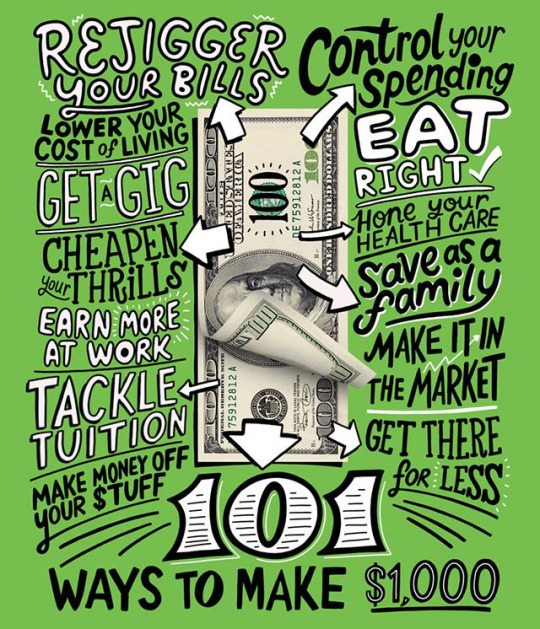

-
PAULA SCHER


-
DAVID CARSON


-
JESSICA HISCHE


-
I also watched these short youtube videos as follow-ups to the seminar.
youtube
youtube
youtube
youtube
4 notes
·
View notes
Text
How can a commercial interior professional integrate branding elements into office design?
Title: Crafting Identity: Integrating Branding Elements into Office Design by Commercial Interior Professionals
Introduction:
The office space is no longer merely a functional environment; it has evolved into a powerful extension of a company's brand identity. Commercial interior professionals play a pivotal role in ensuring that the office design not only enhances functionality but also communicates the brand's essence. In this blog, we will explore the strategic methods employed by these professionals to seamlessly integrate branding elements into office design, emphasizing essential interior design keywords.
Brand Integration Through Color Palette:
Color is a powerful tool for conveying brand identity, and commercial interior professionals leverage it to establish a cohesive visual language. Keywords like "brand colors," "color psychology," and "corporate palette" underscore the importance of selecting and integrating colors that align with the brand. From wall colors to furniture accents, every element contributes to a unified and branded aesthetic.
Customized Brand Signage and Logos:
Incorporating brand signage and logos is a direct and impactful method employed by commercial interior professionals. Keywords like "customized signage," "logo placement," and "brand identity display" emphasize the significance of prominently featuring the company's logo and visual identity throughout the office space. This creates a consistent and recognizable brand presence for both employees and visitors.
Thematic Brand Storytelling:
Commercial interior professionals infuse brand storytelling into the design, creating a thematic narrative that reflects the company's values and mission. Keywords such as "brand narrative," "thematic design," and "storytelling elements" highlight the intentional incorporation of design elements that communicate the brand's journey, fostering a deeper connection with employees and visitors alike.
Branded Furnishings and Custom Artwork:
To create a truly immersive brand experience, commercial interior professionals go beyond conventional design elements. Keywords like "branded furnishings," "custom artwork," and "bespoke design elements" convey the idea of incorporating unique and specially crafted furniture pieces and artworks that carry the brand's visual identity, adding a personalized touch to the office environment.
Consistent Typography and Messaging:
Typography plays a crucial role in brand communication, and commercial interior professionals recognize its significance. Keywords such as "consistent typography," "brand messaging," and "typographic identity" highlight the intentional use of fonts and messaging that align with the brand's voice. From motivational quotes to mission statements, every piece of text reinforces the brand identity.
Branded Environmental Graphics:
Environmental graphics serve as dynamic branding elements that can transform a space. Commercial interior professionals utilize keywords like "environmental graphics," "branded wall murals," and "graphic storytelling" to emphasize the strategic placement of graphics that tell the brand's story. These visuals not only contribute to a visually appealing space but also reinforce the brand identity in a subtle yet impactful way.
Employee Engagement Spaces Reflecting Brand Values:
Engagement spaces within the office provide an opportunity to showcase the brand's values and culture. Keywords like "employee engagement areas," "brand-centric breakrooms," and "culture-infused spaces" highlight the intentional design of areas where employees can connect with the brand on a deeper level. These spaces may feature elements that reflect the brand's values, creating a sense of pride and belonging.
Conclusion:
In the hands of commercial interior professionals, office design becomes a canvas for brand expression. By integrating brand colors, custom signage, thematic storytelling, branded furnishings, consistent typography, environmental graphics, and employee engagement spaces reflecting brand values, these professionals create environments that not only enhance functionality but also communicate a brand's identity effectively. The careful use of interior design keywords underscores the intentional and strategic approach taken by these experts to craft office spaces that serve as authentic reflections of a company's brand. One can achieve these by getting in touch with the renowned design and build firm such as Flipspaces, who can help you with the same.
0 notes
Text
How can a commercial interior professional integrate branding elements into office design?
Title: Crafting Identity: Integrating Branding Elements into Office Design by Commercial Interior Professionals
Introduction:
The office space is no longer merely a functional environment; it has evolved into a powerful extension of a company's brand identity. Commercial interior professionals play a pivotal role in ensuring that the office design not only enhances functionality but also communicates the brand's essence. In this blog, we will explore the strategic methods employed by these professionals to seamlessly integrate branding elements into office design, emphasizing essential interior design keywords.
Brand Integration Through Color Palette:
Color is a powerful tool for conveying brand identity, and commercial interior professionals leverage it to establish a cohesive visual language. Keywords like "brand colors," "color psychology," and "corporate palette" underscore the importance of selecting and integrating colors that align with the brand. From wall colors to furniture accents, every element contributes to a unified and branded aesthetic.
Customized Brand Signage and Logos:
Incorporating brand signage and logos is a direct and impactful method employed by commercial interior professionals. Keywords like "customized signage," "logo placement," and "brand identity display" emphasize the significance of prominently featuring the company's logo and visual identity throughout the office space. This creates a consistent and recognizable brand presence for both employees and visitors.
Thematic Brand Storytelling:
Commercial interior professionals infuse brand storytelling into the design, creating a thematic narrative that reflects the company's values and mission. Keywords such as "brand narrative," "thematic design," and "storytelling elements" highlight the intentional incorporation of design elements that communicate the brand's journey, fostering a deeper connection with employees and visitors alike.
Branded Furnishings and Custom Artwork:
To create a truly immersive brand experience, commercial interior professionals go beyond conventional design elements. Keywords like "branded furnishings," "custom artwork," and "bespoke design elements" convey the idea of incorporating unique and specially crafted furniture pieces and artworks that carry the brand's visual identity, adding a personalized touch to the office environment.
Consistent Typography and Messaging:
Typography plays a crucial role in brand communication, and commercial interior professionals recognize its significance. Keywords such as "consistent typography," "brand messaging," and "typographic identity" highlight the intentional use of fonts and messaging that align with the brand's voice. From motivational quotes to mission statements, every piece of text reinforces the brand identity.
Branded Environmental Graphics:
Environmental graphics serve as dynamic branding elements that can transform a space. Commercial interior professionals utilize keywords like "environmental graphics," "branded wall murals," and "graphic storytelling" to emphasize the strategic placement of graphics that tell the brand's story. These visuals not only contribute to a visually appealing space but also reinforce the brand identity in a subtle yet impactful way.
Employee Engagement Spaces Reflecting Brand Values:
Engagement spaces within the office provide an opportunity to showcase the brand's values and culture. Keywords like "employee engagement areas," "brand-centric breakrooms," and "culture-infused spaces" highlight the intentional design of areas where employees can connect with the brand on a deeper level. These spaces may feature elements that reflect the brand's values, creating a sense of pride and belonging.
Conclusion:
In the hands of commercial interior professionals, office design becomes a canvas for brand expression. By integrating brand colors, custom signage, thematic storytelling, branded furnishings, consistent typography, environmental graphics, and employee engagement spaces reflecting brand values, these professionals create environments that not only enhance functionality but also communicate a brand's identity effectively. The careful use of interior design keywords underscores the intentional and strategic approach taken by these experts to craft office spaces that serve as authentic reflections of a company's brand. One can achieve these by getting in touch with the renowned design and build firm such as Flipspaces, who can help you with the same.
0 notes
Text
How do office interior designers near me tailor designs to match a company's branding strategy?
Company Branding
In the realm of office interior design, harmonizing aesthetics with a company's branding strategy is a delicate art. If you're seeking insight into how office interior designers near you tailor designs to match a company's branding strategy, this blog post delves into the expert strategies and considerations employed by these professionals to create cohesive and on-brand workspaces.
1. In-Depth Brand Exploration:
The journey toward a tailor-made office design begins with an in-depth exploration of the company's brand. Office interior designers near you initiate discussions to understand the brand's core values, mission, vision, and unique selling propositions. This comprehensive exploration lays the foundation for aligning the design with the essence of the brand.
2. Reflecting Brand Colors:
One of the most tangible ways designers integrate branding is through color selection. By incorporating the company's brand colors into the office design, designers create a visual connection between the physical workspace and the brand identity. This ensures a consistent and recognizable color palette throughout the office, fostering a sense of brand cohesion.
3. Logo Integration:
The company's logo is a pivotal element of its visual identity. Designers near you strategically integrate the logo into the office design, ensuring it becomes a focal point that reinforces brand recognition. Whether through custom wall graphics, signage, or innovative applications, the logo becomes an integral part of the office's visual landscape.
4. Typography Consistency:
Consistent typography is another crucial aspect of branding that designers carefully incorporate into their designs. Whether it's selecting fonts for signage, wall decals, or other graphic elements, maintaining typographic consistency with the company's brand guidelines contributes to a cohesive and professional visual identity.
5. Brand-Centric Artwork and Graphics:
Artwork and graphics play a pivotal role in reinforcing a company's brand within the workspace. Office interior designers near you collaborate with artists or graphic designers to create custom artwork that aligns with the brand's ethos. From murals to framed prints, these elements serve as a visual storytelling tool that reinforces the brand's narrative.
6. Spatial Branding Narratives:
Designers skillfully weave spatial narratives that align with the brand's story. From the reception area to meeting rooms, each space is curated to convey a consistent brand experience. This holistic approach ensures that every corner of the office communicates the brand's values and resonates with employees and visitors alike.
7. Furniture and Material Selection:
The choice of furniture and materials is a subtle yet impactful way designers align the workspace with a company's branding strategy. Whether it's selecting sleek and modern furniture for a tech-forward brand or incorporating sustainable materials for an eco-conscious company, these choices contribute to a space that reflects the brand's personality.
8. Cultural Alignment:
Understanding a company's culture is essential for designers aiming to tailor an office space to match its branding strategy. By aligning the design with the company's cultural values, designers create a workspace that feels authentic and resonates with employees. This cultural alignment reinforces a sense of belonging and commitment to the brand.
9. Consistent Brand Messaging:
Beyond visuals, designers near you ensure that the office design aligns with the company's brand messaging. Whether through motivational quotes on walls, mission statements incorporated into the design, or brand-related storytelling elements, the office becomes a physical manifestation of the brand's ethos and narrative.
10. Flexibility for Evolution:
A forward-thinking approach guides designers in creating designs that accommodate a company's future growth and evolving branding strategies. The flexibility to adapt the office space ensures that it remains a dynamic reflection of the brand, capable of accommodating changes and expansions without compromising brand coherence.
In conclusion, office interior designers near me employ a multifaceted approach to tailor designs that align seamlessly with a company's branding strategy. From color palettes to logo integration, spatial narratives to cultural alignment, these professionals navigate the intricate process of transforming a physical workspace into a powerful extension of a brand's identity. The result is an office that not only looks impressive but also serves as a compelling embodiment of the company's values and vision. One can achieve these by getting in touch with the renowned design and build firm such as Flipspaces, who can help you with the same.
0 notes
Text
How can a commercial interior professional integrate branding elements into office design?
Title: Crafting Identity: Integrating Branding Elements into Office Design by Commercial Interior Professionals
Introduction:
The office space is no longer merely a functional environment; it has evolved into a powerful extension of a company's brand identity. Commercial interior professionals play a pivotal role in ensuring that the office design not only enhances functionality but also communicates the brand's essence. In this blog, we will explore the strategic methods employed by these professionals to seamlessly integrate branding elements into office design, emphasizing essential interior design keywords.
Brand Integration Through Color Palette:
Color is a powerful tool for conveying brand identity, and commercial interior professionals leverage it to establish a cohesive visual language. Keywords like "brand colors," "color psychology," and "corporate palette" underscore the importance of selecting and integrating colors that align with the brand. From wall colors to furniture accents, every element contributes to a unified and branded aesthetic.
Customized Brand Signage and Logos:
Incorporating brand signage and logos is a direct and impactful method employed by commercial interior professionals. Keywords like "customized signage," "logo placement," and "brand identity display" emphasize the significance of prominently featuring the company's logo and visual identity throughout the office space. This creates a consistent and recognizable brand presence for both employees and visitors.
Thematic Brand Storytelling:
Commercial interior professionals infuse brand storytelling into the design, creating a thematic narrative that reflects the company's values and mission. Keywords such as "brand narrative," "thematic design," and "storytelling elements" highlight the intentional incorporation of design elements that communicate the brand's journey, fostering a deeper connection with employees and visitors alike.
Branded Furnishings and Custom Artwork:
To create a truly immersive brand experience, commercial interior professionals go beyond conventional design elements. Keywords like "branded furnishings," "custom artwork," and "bespoke design elements" convey the idea of incorporating unique and specially crafted furniture pieces and artworks that carry the brand's visual identity, adding a personalized touch to the office environment.
Consistent Typography and Messaging:
Typography plays a crucial role in brand communication, and commercial interior professionals recognize its significance. Keywords such as "consistent typography," "brand messaging," and "typographic identity" highlight the intentional use of fonts and messaging that align with the brand's voice. From motivational quotes to mission statements, every piece of text reinforces the brand identity.
Branded Environmental Graphics:
Environmental graphics serve as dynamic branding elements that can transform a space. Commercial interior professionals utilize keywords like "environmental graphics," "branded wall murals," and "graphic storytelling" to emphasize the strategic placement of graphics that tell the brand's story. These visuals not only contribute to a visually appealing space but also reinforce the brand identity in a subtle yet impactful way.
Employee Engagement Spaces Reflecting Brand Values:
Engagement spaces within the office provide an opportunity to showcase the brand's values and culture. Keywords like "employee engagement areas," "brand-centric breakrooms," and "culture-infused spaces" highlight the intentional design of areas where employees can connect with the brand on a deeper level. These spaces may feature elements that reflect the brand's values, creating a sense of pride and belonging.
Conclusion:
In the hands of commercial interior professionals, office design becomes a canvas for brand expression. By integrating brand colors, custom signage, thematic storytelling, branded furnishings, consistent typography, environmental graphics, and employee engagement spaces reflecting brand values, these professionals create environments that not only enhance functionality but also communicate a brand's identity effectively. The careful use of interior design keywords underscores the intentional and strategic approach taken by these experts to craft office spaces that serve as authentic reflections of a company's brand. One can achieve these by getting in touch with the renowned design and build firm such as Flipspaces, who can help you with the same.
0 notes
Text
How do office interior designers near me tailor designs to match a company's branding strategy?
Title: Crafting Identity: How Office Interior Designers Near Me Tailor Designs to Align with Company Branding
In the realm of office interior design, harmonizing aesthetics with a company's branding strategy is a delicate art. If you're seeking insight into how office interior designers near you tailor designs to match a company's branding strategy, this blog post delves into the expert strategies and considerations employed by these professionals to create cohesive and on-brand workspaces.
1. In-Depth Brand Exploration:
The journey toward a tailor-made office design begins with an in-depth exploration of the company's brand. Office interior designers near you initiate discussions to understand the brand's core values, mission, vision, and unique selling propositions. This comprehensive exploration lays the foundation for aligning the design with the essence of the brand.
2. Reflecting Brand Colors:
One of the most tangible ways designers integrate branding is through color selection. By incorporating the company's brand colors into the office design, designers create a visual connection between the physical workspace and the brand identity. This ensures a consistent and recognizable color palette throughout the office, fostering a sense of brand cohesion.
3. Logo Integration:
The company's logo is a pivotal element of its visual identity. Designers near you strategically integrate the logo into the office design, ensuring it becomes a focal point that reinforces brand recognition. Whether through custom wall graphics, signage, or innovative applications, the logo becomes an integral part of the office's visual landscape.
4. Typography Consistency:
Consistent typography is another crucial aspect of branding that designers carefully incorporate into their designs. Whether it's selecting fonts for signage, wall decals, or other graphic elements, maintaining typographic consistency with the company's brand guidelines contributes to a cohesive and professional visual identity.
5. Brand-Centric Artwork and Graphics:
Artwork and graphics play a pivotal role in reinforcing a company's brand within the workspace. Office interior designers near you collaborate with artists or graphic designers to create custom artwork that aligns with the brand's ethos. From murals to framed prints, these elements serve as a visual storytelling tool that reinforces the brand's narrative.
6. Spatial Branding Narratives:
Designers skillfully weave spatial narratives that align with the brand's story. From the reception area to meeting rooms, each space is curated to convey a consistent brand experience. This holistic approach ensures that every corner of the office communicates the brand's values and resonates with employees and visitors alike.
7. Furniture and Material Selection:
The choice of furniture and materials is a subtle yet impactful way designers align the workspace with a company's branding strategy. Whether it's selecting sleek and modern furniture for a tech-forward brand or incorporating sustainable materials for an eco-conscious company, these choices contribute to a space that reflects the brand's personality.
8. Cultural Alignment:
Understanding a company's culture is essential for designers aiming to tailor an office space to match its branding strategy. By aligning the design with the company's cultural values, designers create a workspace that feels authentic and resonates with employees. This cultural alignment reinforces a sense of belonging and commitment to the brand.
9. Consistent Brand Messaging:
Beyond visuals, designers near you ensure that the office design aligns with the company's brand messaging. Whether through motivational quotes on walls, mission statements incorporated into the design, or brand-related storytelling elements, the office becomes a physical manifestation of the brand's ethos and narrative.
10. Flexibility for Evolution:
A forward-thinking approach guides designers in creating designs that accommodate a company's future growth and evolving branding strategies. The flexibility to adapt the office space ensures that it remains a dynamic reflection of the brand, capable of accommodating changes and expansions without compromising brand coherence.
In conclusion, office interior designers near me employ a multifaceted approach to tailor designs that align seamlessly with a company's branding strategy. From color palettes to logo integration, spatial narratives to cultural alignment, these professionals navigate the intricate process of transforming a physical workspace into a powerful extension of a brand's identity. The result is an office that not only looks impressive but also serves as a compelling embodiment of the company's values and vision. One can achieve these by getting in touch with the renowned design and build firm such as Flipspaces, who can help you with the same.
0 notes
Text
Crafting Identity: Integrating Branding Elements into Office Design by Commercial Interior Professionals
Introduction:
The office space is no longer merely a functional environment; it has evolved into a powerful extension of a company's brand identity. Commercial interior professionals play a pivotal role in ensuring that the office design not only enhances functionality but also communicates the brand's essence. In this blog, we will explore the strategic methods employed by these professionals to seamlessly integrate branding elements into office design, emphasizing essential interior design keywords.
Brand Integration Through Color Palette:
Color is a powerful tool for conveying brand identity, and commercial interior professionals leverage it to establish a cohesive visual language. Keywords like "brand colors," "color psychology," and "corporate palette" underscore the importance of selecting and integrating colors that align with the brand. From wall colors to furniture accents, every element contributes to a unified and branded aesthetic.
Customized Brand Signage and Logos:
Incorporating brand signage and logos is a direct and impactful method employed by commercial interior professionals. Keywords like "customized signage," "logo placement," and "brand identity display" emphasize the significance of prominently featuring the company's logo and visual identity throughout the office space. This creates a consistent and recognizable brand presence for both employees and visitors.
Thematic Brand Storytelling:
Commercial interior professionals infuse brand storytelling into the design, creating a thematic narrative that reflects the company's values and mission. Keywords such as "brand narrative," "thematic design," and "storytelling elements" highlight the intentional incorporation of design elements that communicate the brand's journey, fostering a deeper connection with employees and visitors alike.
Branded Furnishings and Custom Artwork:
To create a truly immersive brand experience, commercial interior professionals go beyond conventional design elements. Keywords like "branded furnishings," "custom artwork," and "bespoke design elements" convey the idea of incorporating unique and specially crafted furniture pieces and artworks that carry the brand's visual identity, adding a personalized touch to the office environment.
Consistent Typography and Messaging:
Typography plays a crucial role in brand communication, and commercial interior professionals recognize its significance. Keywords such as "consistent typography," "brand messaging," and "typographic identity" highlight the intentional use of fonts and messaging that align with the brand's voice. From motivational quotes to mission statements, every piece of text reinforces the brand identity.
Branded Environmental Graphics:
Environmental graphics serve as dynamic branding elements that can transform a space. Commercial interior professionals utilize keywords like "environmental graphics," "branded wall murals," and "graphic storytelling" to emphasize the strategic placement of graphics that tell the brand's story. These visuals not only contribute to a visually appealing space but also reinforce the brand identity in a subtle yet impactful way.
Employee Engagement Spaces Reflecting Brand Values:
Engagement spaces within the office provide an opportunity to showcase the brand's values and culture. Keywords like "employee engagement areas," "brand-centric breakrooms," and "culture-infused spaces" highlight the intentional design of areas where employees can connect with the brand on a deeper level. These spaces may feature elements that reflect the brand's values, creating a sense of pride and belonging.
Conclusion:
In the hands of commercial interior professionals, office design becomes a canvas for brand expression. By integrating brand colors, custom signage, thematic storytelling, branded furnishings, consistent typography, environmental graphics, and employee engagement spaces reflecting brand values, these professionals create environments that not only enhance functionality but also communicate a brand's identity effectively. The careful use of interior design keywords underscores the intentional and strategic approach taken by these experts to craft office spaces that serve as authentic reflections of a company's brand.
0 notes
Text
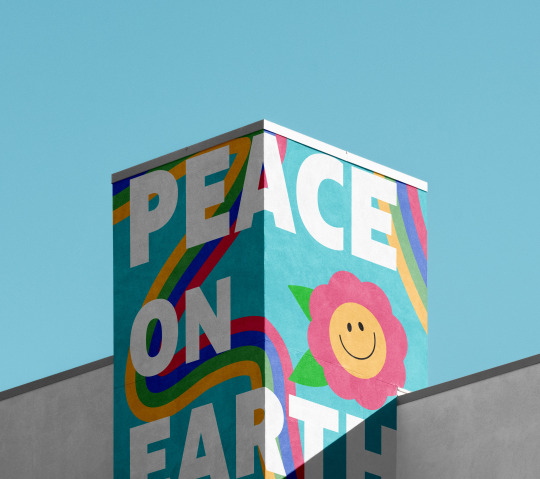
Illo #5: Scale
Topics I chose from:
Night Spectaculars
Super Graphics
Big Book Look
What I chose (and why):
I chose supergraphics to continue testing my abilities in Illustrator and Photoshop. I found putting a bright graphic on a building mockup interesting since I haven't tried it yet.
Supergraphics:
Supergraphics are geometric or typographic designs applied in a large-scale setting. It creates the illusion of a larger or altered space and uses bold colours.
Keywords:
groovy
bold
illusion
mural
attractive
Software: Illustrator, Photoshop
Creative Concept:
The theme for this concept is based on using simple shapes and typography to convey a strong message. I feel that there has been a lot of bad news coming from the world recently, so I created something more positive to put out there. The message 'peace on earth' is the focus of this illo. I created a smile flower and some rainbows to add to the friendliness of the work.
Design Decisions:
I wanted the design to feel simple yet friendly, which is most appropriate for a mural. The flower is placed between the text to strengthen the message. The text is white to stand out against the colours and feel positive. The direction of the rainbow behind the text guides the eye through the illo properly.
1 note
·
View note
Photo

“Remarkable” in Jackson, Michigan
Vibrant Letters Drift and Twist in Bold Typographic Murals by Pref

Left: “Blah blah blah.” Right: “Say bye”
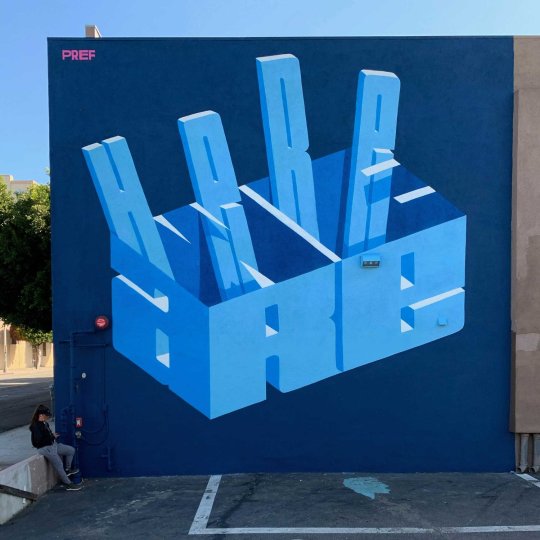
“Here we are” in Los Angeles, California
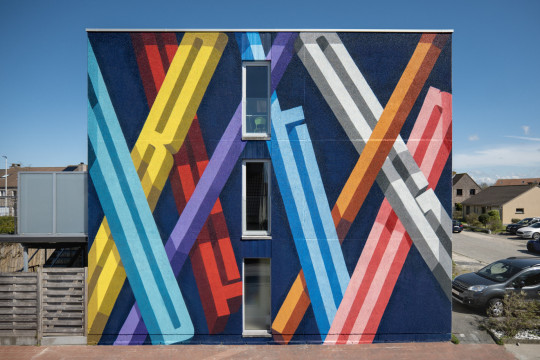
“Drifting” in Ostend, Belgium
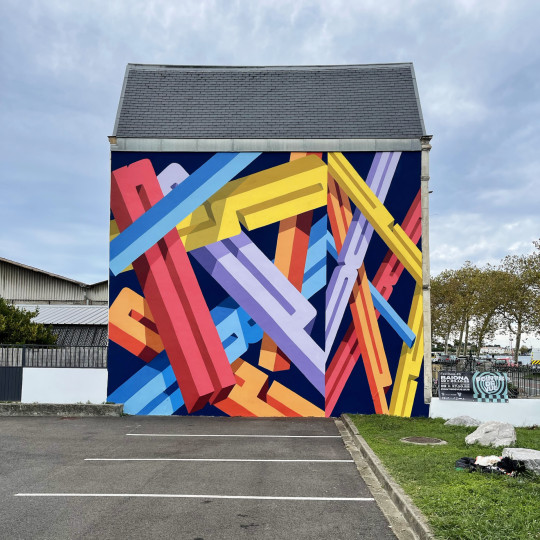
“Inspire, Expire” in Bayonne, France
#pref#artist#art#street artist#street art#murals#typographic murals#letters#jackson#michigan#los angeles#california#ostend#belgium#bayonne#france
0 notes
Text
SEMINAR RESPONSE
Typography seminar
During this seminar , Lorraine discussed the word Typography and what it means. I learned that Typography is a term used to describe how type is arranged on a layout.
Many of serif fonts we use now can be traced back to Ancient Rome or Greece Times, such as the font times new roman.

Gothic calligraphy script was known was Blackletter. Johannas guttenburg created first ever typeface black letter. This was groundbreaking because it had the potential to be accepted by the masses
Roman type styles become popularised in 16th century bc easier to read and aesthetically pleasing
With invention of computers in 20th century , fonts digital version of typefaces become the new currency in typography.
Due to the limitations of screen technology,many fonts were cut out and comic sans was extremely popular.
Then Lorraine asked an vital question. Why is typography important ?
It’s how we show appreciation for each other. It’s how we communicate. It keeps us safe (expiry dates , labelling on food and medicine , on roads and signs )
It’s everywhere in our daily routine .
Influential typographers illustrators and designers from the seminar that inspired me:
Paula scher is a contemporary American artist and graphic designer best known for her posters , logo design and album covers.
Paula believes that the job of the designer is to make things understandable, usable , accessible and enjoyable and importsnt to the public , that involves the Public. For each piece she analyses upwards of 50 different sources. Airline flight patterns, bus times , mileage between cities - some examples
Patterns begin to emerge in her mind and she renders them onto canvas . Unorthodox spacing mixed fonts colours and weights.
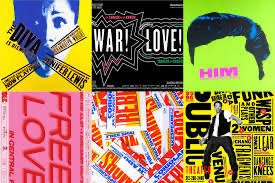

Drake and burgess Johnson. American photographers and designers
Crafted typographic atmospheric imagery for the 1975’s album visuals.
Offering pink neon lights spelling out song titles and set in various backdrops to evoke the sentiment of each tune.
I think these images are so beautiful and there’s something really tranquil and quiet about them

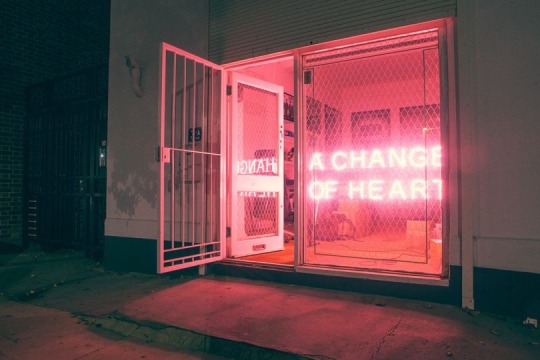
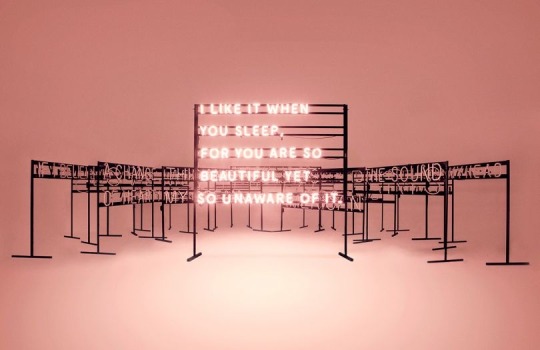
And finally Stephen Powers , an American contemporary artist and muralist. He has created murals in Dublin and Belfast with the assistance of local teenagers. His work in Belfast was inspired by the areas political murals.



I learned from this seminar that anything can be used as a typeface, from shadows to the food we eat. Typography allows you to be super creative and it can be very interactive.
Photography is also a big part in typography which I like.
0 notes
Text
Typographic interventions
Wayfinding and signage - guides the pedestrians and drivers to key destinations within the area.
Historical plaques and markers - provide information about historical signifiance og buildings, landmarks, and streets in the area. Educates and engages.
Mural typography - on building facades or streets can depict local culture, history or important messages, creating a sense of place and identity.
Information kiosks - dynamic typography can provide real time updates on events, services and interactions within the area.
Public Art Installations - Sculptural or three dimentional typographic installations serves as both art and informations
Banners and flags - add vibrancy and celebrate local festivals and special occasions
Digital Displays - typography can display dynamic information such as local news, event listings and public service announcements.
0 notes
Text
Death of the Centre - Brief Notes
11.10.23
Key words:
Typographic Intervention
Re-engaging
Place & Space
Local Histories
Narratives
Reconnect
Wayfinding
Augmented Reality
Branding
Information Design
Initial Ideas:
Colourful, aesthetic, typographic wayfinding
Re-branding of shops
Creating a brand that reconnects and engages the local community to their town centre
Augmented reality - creating an app or a form of Ai
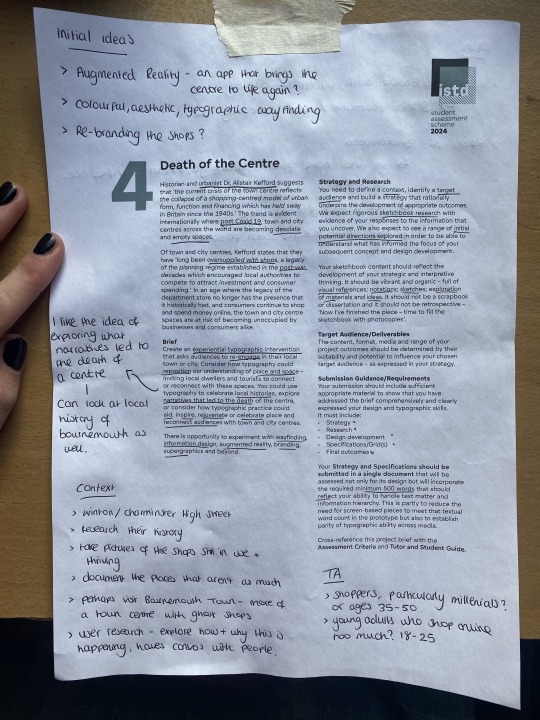
Analysis of brief:
Context: Brief hioghlights the decline of town and city centres as a result of changing consumer behaviour and the oversaturation of shops.
TA: Consider local residents, tourists or a particular demographic that I think is crucial for revitalizing these spaces.
Design development: The brief wants us to explore a range of potential directions before settling on a specific concept. Design should be visually appealing as well as deeply informed by my strategic and research work.
Submission requirements: One single document for the strategy and specs, along with design development and final outcomes. Strategy needs to contain min 500 words.
Initial Ideas:
Local History Celebration: Use typography to narrate the history of the town or city center. Install plaques, signage, or murals that highlight significant historical events or figures, making the area more culturally engaging.
Narratives of Change: Create an installation that visually narrates the transformation of the town or city center over time. Use typography to depict the evolution of the space from its bustling shopping days to its current state.
Interactive Wayfinding: Develop an augmented reality app that guides users through the center, using typography and visual cues to lead them to important landmarks, shops, and points of interest.
Community Engagement: Involve local residents in a typographic project that allows them to express their connection to the town or city center. This could be through public art installations or collaborative mural projects.
Branding Revival: Rebrand the town or city center with a fresh typographic identity that speaks to its unique character and heritage. Use this new branding in wayfinding, signage, and promotional materials.
Temporary Installations: Host events or exhibitions featuring temporary typographic installations that attract people to the area. These could be art displays, interactive installations, or pop-up shops with creative typographic designs.
Collaborative Workshops: Organize typographic workshops or design competitions that encourage local artists and designers to contribute their ideas to reinvigorate the center.
0 notes
Text
Investigative Study Intro
5000 word essay
Choose a subject you are passionate or curious about
Want to hear your voice in essay
Primary and secondary research-interviews, surveys, your own experiments, exhibitions, books, movies and podcasts
Group tutorials and 121 sign ups
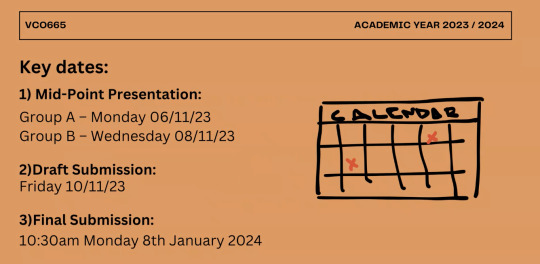
Final Submission:
1: Essay-1 copy submitted on Wiseflow:
Should be in academic format
Title page (name, course details, essay title)
Font 10 point Arial
Double spaced
List of figure
Reference list in Harvard style
2: Designed Cover and Synopsis:
PDF cover that expresses the theme of your essay, with its title and your name
PDF of your synopsis of study typographically set as an internal page
Do's and Don't's:
Under no circumstance use words or ideas of others without a proper citation
Use Harvard referencing
Reference as you go along
Quotes should be pretty short, under 40 words unless vital
Describe the images and visual info in detail
You will need to explain how your witten research is related to your viscom work. A sentence or two can cover the LO of how your research relates to your practice. Are you interested in social innovation, type of sustainability etc
Making a padlet/miro/mural boards will help connect the dots
First person narrative can be really strong
For Friday:

Notes for oral presentation:
Over the summer I had been reading Unwell Women By Elinor Cleghorn, a book about the history of women and medicine. I felt inspired by the stories to look into women's health campaigns and how the visual communication of this has impacted and reflected women's position in society and how, by extension, it has impacted their health. This asserts visual communication as being more than just pretty pictures, but a means for societal change and sadly, continuous reinforcements of patriarchy. Although the book does address western campaigns, I wanted more examples and so looked to All-American Ads by Ed. Jim Heimann from the 40s to 90s. It was interesting to observe how the quantity and openness of advertisements for reproductive health upped steadily with each decade.
My next steps are to look into feminist, marketing and media theories to link into the discussion of the visual language of the campaigns. I studied media at A-Level, but my memory fails me in regards to what theories and language was used to study advertisements, I recall semiotics but that is all, so advice on this would be greatly beneficial to me.
3 keywords:
Feminism, Media, Medicine
0 notes